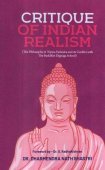Nyayamanjari, Nyāyamañjari: 3 definitions
Introduction:
Nyayamanjari means something in Hinduism, Sanskrit. If you want to know the exact meaning, history, etymology or English translation of this term then check out the descriptions on this page. Add your comment or reference to a book if you want to contribute to this summary article.
In Hinduism
General definition (in Hinduism)
Source: Wisdom Library: HinduismThe Nyāyamañjari (10th century CE) by Jayanta Bhatta is a Sanskrit literary treatise on the Nyāya school of philosophy, but can be regarded as an independent work. Nyāya (“method”) is one of the six orthodox schools of Hinduism who accept the authority of the Vedas, primarily dealing with logic, methodology and metaphysics.
Languages of India and abroad
Sanskrit dictionary
Source: Cologne Digital Sanskrit Dictionaries: Aufrecht Catalogus Catalogorum1) Nyāyamañjarī (न्यायमञ्जरी) as mentioned in Aufrecht’s Catalogus Catalogorum:—Pheh. 13. Rādh. 13. 14. Quoted by Hemādri.
—[nyāya] by Jayanta. Report. Xxv.
—by Jānakīnātha. See Nyāyasiddhāntamañjaṛī.
2) Nyāyamañjarī (न्यायमञ्जरी):—[nyāya] by Jānakīnātha. Ak 835 (inc.). As p. 98 (2 Mss.). Bd. 797. Cs 3, 382. 383 (Śabdakhaṇḍa). 392. 398. 497. Hz. 815. 976 (Pratyakṣa and Śabda). L.. 955-957. C. Nyāyasiddhāntamañjarībhūṣā by Narasiṃha, son of Govinda. Io. 1724. No. 1976. C. by Laugākṣi Bhāskara. Bc 379 (Anumāna). C. Nyāyasiddhāntamañjarīdīpti by Śaṅkara, son of Nīlakaṇṭha Cs 3, 496. C. by some Śiromaṇibhaṭṭācārya. Peters. 5, 211. C. Tarkaprakāśa by Śrīkaṇṭha. Ak 816 (inc.). 817 (inc.). Both anony. As p. 98 (Pratyakṣa). 99 (Anumāna [fragmentary]). Bc 220 (Upamāna and Śabda). 229. 316. Bd. 795 (Śabda). Cs 3, 338. Śabdakhaṇḍa ([fragmentary]). 339 (Pratyakṣa inc.). 392 (1-3). Hz. 816. 892. 969. 1295. Peters. 5, 207 (Pratyakṣa, Upamāna and Śabda). Śg. 2, 175. Tb. 126.
Nyāyamañjarī has the following synonyms: Nyāyasiddhāntamañjarī.
Source: Cologne Digital Sanskrit Dictionaries: Monier-Williams Sanskrit-English DictionaryNyāyamañjarī (न्यायमञ्जरी):—[=ny-āya-mañjarī] [from ny-āya] f. Name of [work]
Sanskrit, also spelled संस्कृतम् (saṃskṛtam), is an ancient language of India commonly seen as the grandmother of the Indo-European language family (even English!). Closely allied with Prakrit and Pali, Sanskrit is more exhaustive in both grammar and terms and has the most extensive collection of literature in the world, greatly surpassing its sister-languages Greek and Latin.
See also (Relevant definitions)
Partial matches: Nyaya, Manjari, Mancari.
Starts with: Nyayamanjarigranthabhanga, Nyayamanjarisara.
Full-text (+33): Nyayamanjarisara, Nyayamanjarigranthabhanga, Trilocana, Arthapariccheda, Jayanta, Pariccheda, Manodosa, Indriyadosha, Dosha, Vishayadosha, Jayanta Bhatta, Shrotra, Vijnanadvaita, Shunyavada, Ishvaranumana, Shrotranumana, Udahrita, Utpadyapratiti, Dvividha, Pramosha.
Relevant text
Search found 26 books and stories containing Nyayamanjari, Nyāyamañjari, Nyāyamañjarī, Nyaya-manjari, Nyāya-mañjarī; (plurals include: Nyayamanjaris, Nyāyamañjaris, Nyāyamañjarīs, manjaris, mañjarīs). You can also click to the full overview containing English textual excerpts. Below are direct links for the most relevant articles:
Contribution of Vachaspati-Mishra to Samkhya System (by Sasikumar. B)
Chapter 2 - Vācaspati Miśra—His life, date and works (introduction)
A History of Indian Philosophy Volume 3 (by Surendranath Dasgupta)
Part 7 - Veṅkaṭanātha’s treatment of pramāṇa < [Chapter XX - Philosophy of the Rāmānuja School of Thought]
A comparative study between Buddhism and Nyaya (by Roberta Pamio)
2.5. Perception according to Jayanta Bhaṭṭa < [Chapter 4 - The Nyāya Theory of Perception]
7. Classification of Perception (Introduction) < [Chapter 3 - The Buddhist Theory of Perception]
4. Kinds of Perception according to Naiyāyikas < [Chapter 4 - The Nyāya Theory of Perception]
A History of Indian Philosophy Volume 1 (by Surendranath Dasgupta)
Part 10 - The Theory of Causation < [Chapter VIII - The Nyāya-Vaiśeṣika Philosophy]
Part 16 - The Doctrine of Momentariness < [Chapter V - Buddhist Philosophy]
Part 22 - Īśvara and Salvation < [Chapter VIII - The Nyāya-Vaiśeṣika Philosophy]
A study of the philosophy of Jainism (by Deepa Baruah)
Chapter I.f - Time of Prabhācandra (Jaina philosopher) < [Chapter I - Introduction]
Nyaya-Vaisheshika categories (Study) (by Diptimani Goswami)
Substance (6): Kāla (Time) < [Chapter 3 - Dravya (Substance)]
Abhāva as a Separate Category < [Chapter 7 - Abhāva (Non-existence)]
Nature of Abhāva < [Chapter 7 - Abhāva (Non-existence)]
Related products
